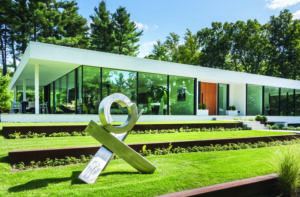The Storyteller
February 17, 2016
Westport photographer Sandi Haber Fifield’s compelling, dreamlike images capture singular and multiple points in time to create expressive, evocative narratives.
Text by Allegra Muzzillo
Sandi Haber Fifield’s photographic journey began during her boarding-school years in Troy, New York. That’s when, she says, “I saw that there’s always a little bit of magic in photography. It drew me in immediately, and the camera felt like home.”
She became riveted by the power of Mary Ellen Mark’s gritty documentary photos, and she credits Mark with further kindling her artistic fire. Haber Fifield, who worked with Mark after graduate school, ultimately chose not to move forward in the documentary style, becoming instead one of the most innovative fine-art photographers of her time.
In the late 1970s, as an MFA student at New York’s Rochester Institute of Technology, Haber Fifield freely experimented with her medium, inspired by such groundbreaking photographers as Robert Heinecken and Thomas Barrow, who created images that went beyond the camera’s typical square frame. She realized that by dissecting a 35mm camera and removing the part responsible for making square images with spaces between them, she could create ongoing, seamless combinations of images on a single film roll. “They’re like the human eye,” she explains. “Always looking, moving, flickering.”
She used that new technique to document trips she took to India and Haiti after grad school, creating continuous, overlapping images that feature gauzy curtains, colorful botanicals, religious statuary, and shadowy presences that evoke calm, warmth, and memories of faraway travel.
In the late 1980s, as a young mother with less time to travel, Haber Fifield found inspiration in the work of postmodern painters such as David Salle, Eric Fischl, and Julian Schnabel, who frequently juxtaposed pop-culture imagery. Her Appropriated photo series, in which she ran rolls of film twice through her camera, consists of stills taken of moving images on her television screen. “MTV was new to the scene,” she notes, “and I was interested in iconography that reflected contemporary life.” Figures captured mid-dance, bright neon lights, a blue-faced Peter Gabriel, and Max Headroom seem to undulate, buzz, and sing.
Just as Haber Fifield’s work is poignantly corollary, it is also ever-evolving. By 2009, when she published her first monograph, Walking Through the World—a single-photo, multiple-photo, and photo-grid-style series, “woven together from feelings, imagination, and facts,” she says—she had wholly converted to digital photography. In the series, she explains, “I tried to create something about what I was feeling.” In one grid, centered on a group of Afghan women mourning the killing of a beloved instructor, “there’s a car speeding past. And there’s a war-torn wall that represents any war-torn place in the world—yet there’s still light and hope.”
Whether presented as continuous, overlapped, side-by-side, or grid-style images, Haber Fifield’s work speaks an ongoing narrative, conveying a total experience.
Her second monograph, 2011’s Between Planting and Picking, is a bit different. Here, single photos, diptychs, and triptychs capture images of American family farms—with the requisite fences and tools—in various stages of growing seasons. Intimate, familiar, and comforting, yet devoid of the farmers themselves, these powerful photos call to mind a simpler time, and depict only what’s in front of the artist’s camera. Here, says Haber Fifield, “I didn’t recreate my reality, as I do in all of my other work.”
After the Threshold, Haber Fifield’s 2013 monograph, comprises triptych and quadriptych photographs exploring the relationship between each image. Lovely, arguably banal pictures in which the natural world features prominently oscillate between soft, grainy, and sharp-as-a-tack. A pretty butterfly alights on a screen and trees cast crisp shadows on a dirt path, each image revealing Haber Fifield’s true mastery.
Her upcoming project, But That One Let Go, is perhaps her most daring. The self-published limited-edition monograph consists of thirteen photos, each accompanied by poems written by Connecticut-based poet David Gorin. Printed on vellum and sitting atop each photo, the poems create a visual conversation. “I hope the viewer has a deeper sense of the photos because of the words,” says Haber Fifield. “It’s all the same piece, and hopefully the experience is enhanced by both together.”
Haber Fifield maintains that she never specifically sets out to make beautiful photographs. “It’s always been about combining things and making something fresh out of that narrative,” she explains. “Beauty just lies in what’s there. It exists in a lot of forms and has infinite possibilities.” •
Editor’s note: Sandi Haber Fifield is represented in New York City by Rick Wester Fine Art, (212) 255-5560, rickwesterfineart.com. To see more of her work, visit sandihaberfifield.com
Share
![NEH-Logo_Black[1] NEH-Logo_Black[1]](https://www.nehomemag.com/wp-content/uploads/2022/08/NEH-Logo_Black1-300x162.jpg)


















You must be logged in to post a comment.